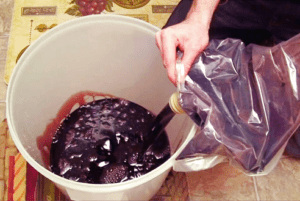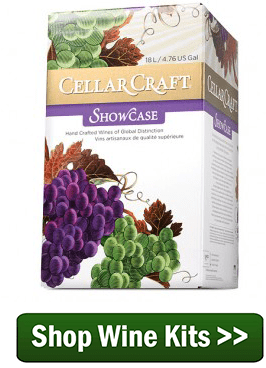Part 1 | Part 2 | Part 3 | Part 4 | Part 5
 Though I’ve been a homebrewer for six years, I haven’t done much in the world of winemaking – until now. Having recently made a mead, I discovered that the process was much less time consuming than homebrewing. With no mash, the “brewing” process was shortened dramatically. So I’ve decided to take things a step further and make my first red wine: a California Connoisseur Shiraz kit from E. C. Kraus.
Though I’ve been a homebrewer for six years, I haven’t done much in the world of winemaking – until now. Having recently made a mead, I discovered that the process was much less time consuming than homebrewing. With no mash, the “brewing” process was shortened dramatically. So I’ve decided to take things a step further and make my first red wine: a California Connoisseur Shiraz kit from E. C. Kraus.
What’s in the Box
The first noticeable difference between this winemaking kit and homebrew recipe kits I’ve made is the sheer weight of the kit. I was surprised to pick it up from my doorstep and discover considerably more heft than a typical beer recipe box kit. Makes sense – almost two gallons of juice weighs some twenty pounds. Compared to about two quarts of malt extract syrup, that extra liquid makes a difference. I should note that the winemaking kit makes six gallons of wine, compared to about five gallons for a typical homebrewing kit.
Opening the Shiraz kit, I discovered some new ingredients I’d never used before. In addition to the grape juice concentrate, the kit also included:
- Wine Yeast – I’m familiar with different types of beer yeast, but I have a lot to learn about wine yeast. This Shiraz kit comes with one packet of Lalvin EC-1118, a French dry yeast recommended for a wide range of wine styles.
- Bentonite – Bentonite is a wine clarifier made from clay. It works by attracting particles with static electricity and when they’re bound together, they settle to the bottom of the fermenter. Bentonite can also reduce off-flavors and oxidation. In this kit, the bentonite is added before fermentation.
- Potassium metabisulfite – Potassium metabisulfite is used to prevent oxidation and increase the shelf life of wine.
- Potassium sorbate – This ingredient helps prevent re-fermentation in the bottle.
- Kieselsol & Chitosan – These are clarifiers, both added after fermentation and before bottling. Just like bentonite, they work by using electric charges to attract oppositely charged particles and help them settle out. Kieselsol is negatively charged, chitosan is positively charged, so when used together they’re like a 1-2 punch to help yeast, protein, and tannin settle out, leaving behind a clear wine.
 The kit also came with pretty extensive instructions (in both English and French).
The kit also came with pretty extensive instructions (in both English and French).
One thing I noticed was that the kit did not include corks. Not to worry. Since I don’t have a corker, a pack of these mushroom corks should do the trick.
Other than that, I have everything else I need to make wine from my homebrewing equipment – the fermenting bucket, carboy, auto-siphon, tubing, airlock, hydrometer, and bung. Plus, I’ve been stocking wine bottles for several months, so I should be all ready to go once it’s time to put this Shiraz in the bottle.
Stay tuned as I compare the winemaking process to homebrewing – this should be interesting!
Part 1 | Part 2 | Part 3 | Part 4 | Part 5
———————————–
David Ackley is a writer, brewer, and craft beer marketing consultant. He holds a General Certificate in Brewing from the Institute of Brewing and Distilling and is founder of the Local Beer Blog.
